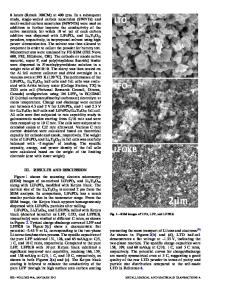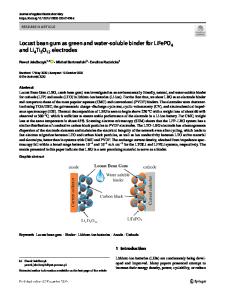Safety Characteristics of the Li 4 Ti 5 O 12 /LiMn 2 O 4 Li-Ion Battery
- PDF / 110,114 Bytes
- 6 Pages / 612 x 792 pts (letter) Page_size
- 6 Downloads / 302 Views
0972-AA13-04
Safety Characteristics of the Li4Ti5O12/LiMn2O4 Li-Ion Battery Ilias Belharouak, Wenquan Lu, and Khalil Amine Chemical Engineering Division, Argonne National Laboratory, 9700 South Cass Avenue, Argonne, IL, 60439
ABSTRACT The Li4Ti5O12/LiMn2O4 cell holds promise for safer operation of lithium-ion batteries. In this study, Li4+xTi5[AE1]O12 anode powder was prepared by chemical lithiation of Li4Ti5O12 in the presence of an excess of butylithium (LiC4H9) in hexane solution, and Li1-yMn2O4 cathode powder was prepared by chemical delithiation of LiMn2O4 spinel using NO2BF4 oxidizer in an acetonitrile medium. Thermal gravimetric analysis showed that the Li1-yMn2O4 releases oxygen starting at 200oC with an overall oxygen loss of 6 wt% at 500oC, whereas the Li4+xTi5O12 gains oxygen starting at 200oC with an overall oxygen gain of 4 wt% at 500oC. The reactivity of Li4+xTi5O12 and Li1-yMn2O4 powders in the presence of electrolyte was also investigated by differential scanning calorimetry between room temperature and 375oC. The results suggest that the Li4+xTi5O12 anode is thermally more stable compared with the conventional lithiated graphite anode.
INTRODUCTION To overcome the problem of thermal runaway in lithium-ion cells, battery companies have tried electrolyte additives, shutdown separators, positive thermal coefficient devices, and— for even more protection— combinations of these safety components [1]. The high cost of these safety measures will likely reduce the chance of this technology meeting the cost requirements for applications requiring large lithium-ion batteries, such as hybrid electric vehicles [2-3]. To address the safety limitations of lithium-ion cells, particularly those containing nickelbased cathodes, researchers have studied alternative anodes to graphite, such as the spinel Li4Ti5O12, which operates at 1.5 V vs. Li metal, thereby providing an electrode system with much better safety characteristics. Indeed, at this high cutoff voltage, the solid-electrolyte interface (SEI) film that occurs for the conventional graphite anode does not form or at least is much thinner, because the reduction of the organic species and transition metal ions only occurs below 1 V. In addition, unlike the graphite anode, no volume change is expected during the insertion of three lithium atoms into the spinel structure, which leads to the formation of a rock-salt type Li7Ti5O12 material with a zero-strain structural character [4]. Moreover, this anode can be coupled with a 4-V electrode, such as LiMn2O4, to form a cell system operating at 2.5 V, which is twice that of a nickel-metal hydride cell. This paper reports on the thermal and structural stability of Li4Ti5O12 and LiMn2O4 powders after chemical lithiation and delithiation, respectively. The thermal and structural stability of Li4+xTi5O12 and Li1-yMn2O4 powders was investigated by thermal gravimetric analysis (TGA) combined with x-ray diffraction (XRD). The reactivity of these powders with electrolyte was also investigated by differential scanning calo
Data Loading...











